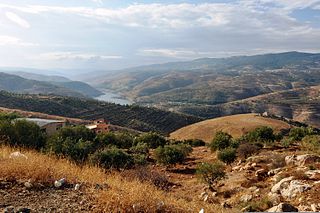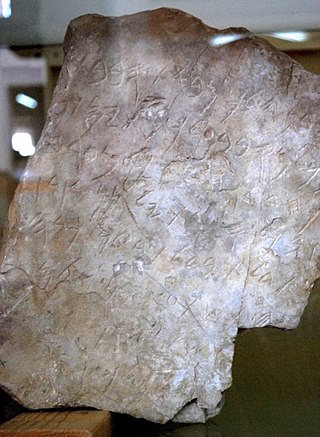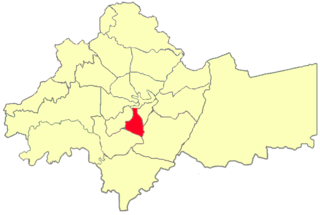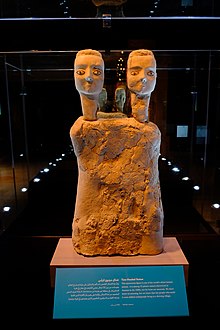
Amman is the capital and the largest city of Jordan, and the country's economic, political, and cultural center. With a population of 4,061,150 as of 2021, Amman is Jordan's primate city and is the largest city in the Levant region, the fifth-largest city in the Arab world, and the tenth-largest metropolitan area in the Middle East.

Moab is an ancient Levantine kingdom whose territory is today located in southern Jordan. The land is mountainous and lies alongside much of the eastern shore of the Dead Sea. The existence of the Kingdom of Moab is attested to by numerous archaeological findings, most notably the Mesha Stele, which describes the Moabite victory over an unnamed son of King Omri of Israel, an episode also noted in 2 Kings 3. The Moabite capital was Dibon. According to the Hebrew Bible, Moab was often in conflict with its Israelite neighbours to the west.

The Dead Sea Scrolls, also called the Qumran Caves Scrolls, are a set of ancient Jewish manuscripts from the Second Temple period. They were discovered over a period of 10 years, between 1946 and 1956, at the Qumran Caves near Ein Feshkha in the West Bank, on the northern shore of the Dead Sea. Dating from the 3rd century BCE to the 1st century CE, the Dead Sea Scrolls include the oldest surviving manuscripts of entire books later included in the biblical canons, along with extra-biblical and deuterocanonical manuscripts from late Second Temple Judaism. At the same time, they cast new light on the emergence of Christianity and of Rabbinic Judaism. Almost all of the 15,000 scrolls and scroll fragments are held in the Shrine of the Book at the Israel Museum, located in the city of Jerusalem. The Israeli government's custody of the Dead Sea Scrolls is disputed by Jordan and the Palestinian Authority on territorial, legal, and humanitarian grounds—they were mostly discovered following the Jordanian annexation of the West Bank and were acquired by Israel after Jordan lost the 1967 Arab–Israeli War—whilst Israel's claims are primarily based on historical and religious grounds, given their significance in Jewish history and in the heritage of Judaism.

Moses Wilhelm Shapira was a Jerusalem antiquities dealer and purveyor of both authentic and forged Semitic antiquities, including some allegedly Biblical artifacts, the most high profile of which was the Shapira Scroll. The shame brought about by accusations that he was involved in the forging of that specific allegedly ancient biblical text and the difficult situation created by the scandal drove him to suicide in 1884. Recent scholarship by Idan Dershowitz says that the Shapira Scroll may have been authentic and a predecessor to the canonical book of Deuteronomy.

The Mesha Stele, also known as the Moabite Stone, is a stele dated around 840 BCE containing a significant Canaanite inscription in the name of King Mesha of Moab. Mesha tells how Chemosh, the god of Moab, had been angry with his people and had allowed them to be subjugated to the Kingdom of Israel, but at length, Chemosh returned and assisted Mesha to throw off the yoke of Israel and restore the lands of Moab. Mesha also describes his many building projects. It is written in a variant of the Phoenician alphabet, closely related to the Paleo-Hebrew script.

Chemosh was an ancient Semitic deity whose existence is recorded during the Iron Age. Chemosh was the supreme deity of the Canaanite state of Moab and the patron-god of its population, the Moabites, who in consequence were called the "People of Chemosh". Chemosh is primarily attested from Moabite inscriptions and the Hebrew Bible.

The Rockefeller Archeological Museum, formerly the Palestine Archaeological Museum, is an archaeology museum located in East Jerusalem, next to Herod's Gate, that houses a large collection of artifacts unearthed in the excavations conducted in the British-ruled Mandatory Palestine, mainly in the 1920s and 1930s.

Lime plaster is a type of plaster composed of sand, water, and lime, usually non-hydraulic hydrated lime. Ancient lime plaster often contained horse hair for reinforcement and pozzolan additives to reduce the working time.

Dhiban, known to the Moabites as Dibon, is a Jordanian town located in Madaba Governorate, approximately 70 kilometres south of Amman and east of the Dead Sea. Previously nomadic, the modern community settled the town in the 1950s. Dhiban's current population is about 15,000, with many working in the army, government agencies, or in seasonal agricultural production. A number of young people study in nearby universities in Karak, Madaba, and Amman. Most inhabitants practice Islam.

Ayn Ghazal is a Neolithic archaeological site located in metropolitan Amman, Jordan, about 2 km north-west of Amman Civil Airport. The site is remarkable for being the place where the ʿAin Ghazal statues were found, which are among the oldest large-sized statues ever discovered.

The Wadi Mujib, also known as Arnon Stream, is a river in Jordan. The river empties into the Dead Sea circa 420 metres (1,380 ft) below sea level.

Jordanian art has a very ancient history. Some of the earliest figurines, found at Aïn Ghazal, near Amman, have been dated to the Neolithic period. A distinct Jordanian aesthetic in art and architecture emerged as part of a broader Islamic art tradition which flourished from the 7th-century. Traditional art and craft is vested in material culture including mosaics, ceramics, weaving, silver work, music, glass-blowing and calligraphy. The rise of colonialism in North Africa and the Middle East, led to a dilution of traditional aesthetics. In the early 20th-century, following the creation of the independent nation of Jordan, a contemporary Jordanian art movement emerged and began to search for a distinctly Jordanian art aesthetic that combined both tradition and contemporary art forms.

The Pre-Pottery Neolithic (PPN) represents the early Neolithic in the Levantine and upper Mesopotamian region of the Fertile Crescent, dating to c. 12,000 – c. 8,500 years ago,. It succeeds the Natufian culture of the Epipalaeolithic Near East, as the domestication of plants and animals was in its formative stages, having possibly been induced by the Younger Dryas.

The Jordan Archaeological Museum is located in the Citadel of Amman, Jordan. Built in 1951, it presents artifacts from archaeological sites in Jordan, dating from prehistoric times to the 15th century. The collections are arranged in chronological order and include items of everyday life such as flint, glass, metal and pottery objects, as well as more artistic items such as jewelry and statues. Highlights of the museum collections include some of the ʿAin Ghazal statues, which are among oldest statues ever made, and plastered human skulls from Jericho. The museum also includes a coin collection.

The Zarqa River is the second largest tributary of the lower Jordan River, after the Yarmouk River. It is the third largest river in the region by annual discharge and its watershed encompasses the most densely populated areas east of the Jordan River. The Zarqa rises in springs near Amman, and flows through a deep and broad valley into the Jordan, at an elevation 1,090 metres (3,580 ft) lower.
Lorenzo Nigro is an Italian archaeologist, novelist and watercolorist. He is Full Professor of Near Eastern Archaeology in the Faculty of Letters and Philosophy at Sapienza University of Rome. He directs three main archaeological expeditions: at Jericho in Palestine, with the Ministry of Tourism and Antiquities, at the Early Bronze Age fortified city, previously unknown, of Khirbet al-Batrawy in the Hashemite Kingdom of Jordan, and at Motya, a Phoenician city in Western Sicily, while also acting as co-director of the Institut national du patrimoine-Sapienza University of Rome Expedition to Carthage in Tunisia. Since 2015 he started the archaeological exploration and protection activities, again in cooperation with the Palestinian Ministry of Tourism and Antiquities, in the Bronze and Iron Age necropolises of the Bethlehem urban area and at the site of Tell esh-Sheikh Abu Zarad, ancient Tappuah. In all these excavations he has been the protagonist of several important discoveries, from the reconstruction of the Bronze Age city at Jericho, to the Temple of the Kothon at Motya, to the entire unknown city of Batrawy with its magnificent fortifications and the Palace of the Copper Axes, and the Broad Room temple. At Motya it has uncovered at least four temples and detailed a prehistoric stratigraphy at the foot of the acropolis showing that the island in Sicily was occupied and known to Mediterranean sailormen since the beginning of the 2nd millennium BC.

Plastered human skulls are human skulls covered in layers of plaster and typically found in the ancient Levant, most notably around the modern Palestinian city of Jericho, between 8,000 and 6,000 BC, in the Pre-Pottery Neolithic B period. They represent some of the oldest forms of art in the Middle East and demonstrate that the prehistoric population took great care in burying their ancestors below their homes. The skulls denote some of the earliest sculptural examples of portraiture in the history of art.

The Amman Citadel Inscription is the oldest known inscription in the so-called Ammonite language. It was discovered in 1961 in the Amman Citadel, and first published in full in 1968 by Siegfried Horn. At the time of its discovery it was the third longest Semitic stone inscription ever found in the Southern Levant, after the Mesha Stele and the Siloam inscription. The inscription is known as KAI 307. As of 1969, the inscription was on display at the Jordan Archaeological Museum.

The ʿAin Ghazal statues are a number of large-scale lime plaster and reed statues discovered at the archaeological site of ʿAin Ghazal in Amman, Jordan, dating back to approximately 9000 years ago, from the Pre-Pottery Neolithic C period. A total of 15 statues and 15 busts were discovered in 1983 and 1985 in two underground caches, created about 200 years apart.

Ras al-Ein is one of the 22 administrative sub-districts of the city of Amman, Jordan, as governed by the Greater Amman Municipality.























